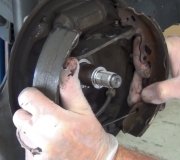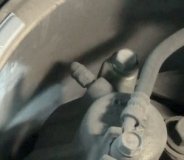Normally all rebuilt master cylinders come with the kit which consists of two black or clear hoses, roughly 8" long, and two plastic fittings to screw into the outlet ports. You install the fittings, and run the hoses from them back up into the reservoir. Clamp the mounting ear of the master cylinder in a vise, fill the reservoir with new, clean brake fluid, then use a philips screwdriver or some other push rod to push the pistons in repeatedly. Fluid and air will go through the hoses into the reservoir. Keep the ends of the hoses in the fluid so air won't be drawn back in when you release the pistons.
There's two types of plastic fittings. The standard ones are just tubes to hook the hoses to. You have to squeeze the hoses closed when you release the pistons, otherwise the fluid and air will just move back and forth and the air won't be expelled. The better fittings only have one or two holes on the sides of the nipples. Those are obstructed by the hoses forming check valves. The fluid under a slight pressure when you press the pistons pushes through those holes but when you release the pistons, the hoses block the fluid and air from returning. They work better by squeezing the hoses closed for you.
I'd be surprised if you didn't get those fittings with the new master cylinder, but if you didn't, almost any mechanic who does brake work will have some to give to you. I always saved the ones I got just in case.
Since you already have the master cylinder installed on the vehicle, you may be able to do the bench-bleeding right there. Just remove the steel lines, and use the brake pedal instead of a vise and screwdriver. Be aware that brake fluid will eat paint so wash any off that gets on the firewall or inner fender. Where this will not work is on vehicles where the master cylinder sits at an angle, ... Higher in front than at the back. That allows air to get trapped at the high spot which is higher than where the fluid comes out of the front port. That was more common on older GM vehicles.
Here's another trick you can use when you're only replacing the master cylinder. There will be no air in the steel lines so there's no need to bleed at the wheels. Loosen the lines slightly at the master cylinder so you don't have to struggle later. Unbolt it from the power booster, then use it as a handle to bend the steel lines up a little. That will prevent the fluid from running out of that last inch or two of tubing. Do your bench-bleeding, then install the master cylinder to the steel lines. Make the fittings finger-tight, then push down to bend the lines back to where they where. Bolt the master to the power booster, then have a helper slowly push the pedal half way to the floor. It should take him at least 20 seconds. During that time you'll see air bubbles coming from around the fittings. Snug those fittings before your helper releases the pedal. When he does, the pedal should be released quickly. Crack each fitting loose once more, then have him press the pedal slowly again. Tighten the fittings, then have him release the pedal quickly. By pressing the pedal slowly, the air bubbles that might go down the lines will float back up to the high spots while the fluid travels down toward the wheels. When he releases the pedal quickly, the fluid rushing back into the reservoir will wash any air bubbles with it. This isn't as effective on Ford products that have four steel lines, two on each side, coming out of the master cylinder but it can still work.
There's two reasons to never push a brake pedal more than half way to the floor. Neither applies to you. On any master cylinder more than about a year old, crud and corrosion build up in the bottom halves of the two bores where the pistons don't normally travel. In the case of pedal-bleeding, or when a driver is surprised by the sudden loss of a solid pedal due to a leak, running the pedal to the floor runs the lip seals over that corrosion and can rip them. That results in internal leakage and the need to replace the master cylinder. Often that damage doesn't show up for a few days. Experienced mechanics know to expect this type of failure when anything else has sprung a leak and they'll often include its replacement in the repair estimate.
The second reason applies to GM front-wheel-drive vehicles. Pushing the pedal too far will trip a "pressure-differential" valve in the master cylinder and cause it to block fluid flow to two wheels. Often drivers don't even notice the loss of half of the braking system until one set of front pads wears out and the other side looks like new yet. The clue for the mechanic is one front wheel and the opposite rear wheel won't flow any fluid and can't be bled.
Wednesday, January 2nd, 2013 AT 1:55 AM


